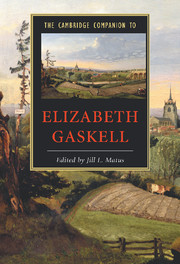Book contents
- Frontmatter
- 1 Introduction
- 2 The life and letters of E. C. Gaskell
- 3 Mary Barton and North and South
- 4 Cranford and Ruth
- 5 Elizabeth Gaskell’s The Life of Charlotte Brontë
- 6 Sylvia’s Lovers and other historical fiction
- 7 Cousin Phillis, Wives and Daughters, and modernity
- 8 Elizabeth Gaskell’s shorter pieces
- 9 Gaskell, gender, and the family
- 10 Elizabeth Gaskell and social transformation
- 11 Unitarian dissent
- 12 Gaskell then and now
- Guide to further reading
- Index
- Series List
1 - Introduction
Published online by Cambridge University Press: 28 May 2007
- Frontmatter
- 1 Introduction
- 2 The life and letters of E. C. Gaskell
- 3 Mary Barton and North and South
- 4 Cranford and Ruth
- 5 Elizabeth Gaskell’s The Life of Charlotte Brontë
- 6 Sylvia’s Lovers and other historical fiction
- 7 Cousin Phillis, Wives and Daughters, and modernity
- 8 Elizabeth Gaskell’s shorter pieces
- 9 Gaskell, gender, and the family
- 10 Elizabeth Gaskell and social transformation
- 11 Unitarian dissent
- 12 Gaskell then and now
- Guide to further reading
- Index
- Series List
Summary
In the past few decades, Elizabeth Gaskell has become a figure of growing importance in the field of Victorian literary studies. It is now widely recognized that she produced work of great variety and scope in the course of a highly successful writing career that lasted for about twenty years. A gifted storyteller, with a zest for anecdote, legend, and social observation, she was innovative and experimental in her use of genre, particularly in the realm of shorter fiction. She is significant also in the history of biography, where her controversial contribution, The Life of Charlotte Brontë (1857), was instrumental in changing conceptions of that genre. Nurtured by the rich social and religious context of nineteenth-century Unitarianism, Gaskell is typically open-minded in response to social transformation and change. This is evident in her early fiction in the treatment of the problems of working-class life and prostitution as well as in her last novel's magisterial representation of provincial life in the context of changing social structures and gender and class relations. Generations of readers have valued her for her geniality, sympathy, and imaginative expressiveness, but critics are increasingly coming to acknowledge that she is neither artless nor transparent. They are also granting growing recognition to her intellectuality, her familiarity with matters of scientific, economic, and theological inquiry, and her narrative sophistication.
- Type
- Chapter
- Information
- The Cambridge Companion to Elizabeth Gaskell , pp. 1 - 9Publisher: Cambridge University PressPrint publication year: 2007

